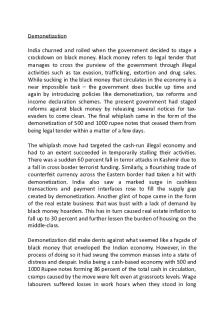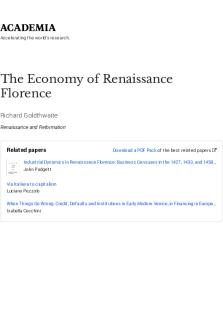Literature Review - The Impact of Oil prices on and the Economy PDF

| Title | Literature Review - The Impact of Oil prices on and the Economy |
|---|---|
| Course | Economics |
| Institution | University of Portsmouth |
| Pages | 6 |
| File Size | 100.9 KB |
| File Type | |
| Total Downloads | 22 |
| Total Views | 135 |
Summary
The Impact of Oil prices on and the Economy
...
Description
The Impact of Oil prices on the Economy The Economists Toolkit 2 – Literature review Unit Code: U20441
In my research, I will review the existing literature considering oil prices and their effect on the economy. The quick and substantial increments in the oil prices experienced over the decades have created widespread concern worldwide. The concern is based the effect of oil prices on the economy. This review deals with what economic hypothesis and empirical studies say in regards to the effect of rising oil prices with reference to oil-importing and exporting nations. In recent decades, the price of oil has varied considerably and such fluctuations bring great deal of attention particularly for most industrialized nations to see the relationship between GDP and oil prices. Aggregate demand is expected to fall in oil importing countries and go up in oil exporting countries (Jiménez-Rodríguez and Sánchez, 2009). Using structural models such as a CGE model, (Timilsina, 2015) found an oil price rise during 2002–2008 period would cause a 2% to 3% loss of GDP per year in 6 oil-importing nations (Bangladesh, El Salvador, Kenya, Nicaragua, Tanzania, and Thailand) (Timilsina, 2015). In relation, (Rogoff, 2006) stated the global output decreased by at least 1.5% cumulatively as the oil price doubled between 2003 and 2005. Although the losses seem to be relatively modest of the impact of previous oil shock episodes, which coincided with more drops in world GDP growth (Rogoff, 2006). The effect on GDP of the mid 1970s and early 1980s are more obvious of risen oil prices (Jiménez-Rodríguez and Sánchez, 2009). 5 to 10 years on, the oil market could be on the opposite side of the cycle (falling oil prices), in spite of the long haul upward pressure due to emerging countries (Rogoff, 2006). The rapid cuts in worldwide GDP in all scenarios occur during the early part of the time skyline, given the general inelasticity of demand for oil in the short term (Timilsina, 2015). In view of the large fixed costs and long lead times involved in oil extraction projects, the industry has a tendency to under and over-invest, resulting in price cycles. The underinvestment in the market when there was a low price of oil in the 1990s, reflect the current prices of today. Conversely, the expenses of longer-term oil value instability are to a great degree problematic for nations that depend highly on oil production. These nations are not just profoundly vulnerable against short run variances in their revenues, but also to longer run variances that occur from investment cycles in the oil sector. Due to the long lead times in investing into new oil discovery and generation, and capital expenditure, it is not shocking (due to under and over-investment) to see huge long-term fluctuations in oil prices (Rogoff, 2006). Comparatively, (Jiménez-Rodríguez and Sánchez, 2009) recorded decomposition analysis demonstrates the effect of oil prices on economics movement is visible from the oil disasters of mid-1970s and early 1980s. Inflation also increases in many countries, as well as in later years of rising oil prices: such as, 1999–2000 and the 1990 spike (Jiménez-Rodríguez and Sánchez, 2009). Although, globalization has helped economies of keeping low inflation less difficult in short term cases, compared to the major oil shocks in earlier instances. (Rogoff, 2006)
The time series estimates that the GDP impacts of oil price shocks depend significantly on whether the observed oil price changes were exogenous or endogenously induced by other factors. GDP flexibility would shift across nations relying on the ability to adjust to oil price shocks (Timilsina, 2015). Helping producers broaden economic risks could possibly be the most prominent issue currently for the world economy. For both short and long haul oil prices, unpredictability is still a massive issue for oil-producing nations, regardless of the effects on worldwide economies. A larger buffer stock of oil supplies can ease short-term fluctuations, although by a restricted degree (Rogoff, 2006). The impact of biofuels in relieving the effects of rising oil costs is generally little in light of the fact that the limit of biofuels to monetarily substitute for oil at a worldwide scale is restricted (Timilsina, 2015). It can be argued the long-term instability maybe be decreased by more clearness in the sector, however, long haul cycles of under and over-investment are likely to continue in the industry. (Rogoff, 2006)
Some countries have managed to deal with oil price fluctuations through exchange rate flexibility. Every so often, when measured in different currencies, dollar exchange rate instability suggests that oil prices drift. However, oil price unpredictability swamps exchange rate developments; hence, oil shocks have been worldwide, in certain cases resulting in a global recession. Over time, oil-exporting out nations would have the capacity to better protect their diversification and reducing the chance of deflation that would generally occur otherwise (Rogoff, 2006). An exchange rate appreciation for an importing country can counterbalance some of the positive terms-of-exchange stun to oil trading nations (JiménezRodríguez and Sánchez, 2009). In addition, (Jiménez-Rodríguez and Sánchez, 2009) studied the euro economy and concentrated on past outcomes demonstrating the commitment of oil prices to inflation and GDP. The methodology utilized does not anticipate the causality to go just from the value of oil to macro-economic components, permitting the last to influence the previous also. Using a US deflator, (Jiménez-Rodríguez and Sánchez, 2009) opted to collapse oil prices and after that deflating using a domestic price index. Thus, utilization of the US deflator, with the consideration of the genuine conversion rate in the VAR model, permits better disintegration with direct effect from the oil shock and the backhanded impacts by means of transmission channels, including those including domestic inflation and nominal exchange rate. Furthermore, this encourages comparability of the outcomes, which keeps constant the identity of the shocks over nations. (Jiménez-Rodríguez and Sánchez, 2009) defined a time whereby the oil price overtakes the average of the entire sample. From this standard, (Jiménez-Rodríguez and Sánchez, 2009) permitted a random period to incorporate separate quarters that includes a short-term plunge underneath the sample mean. As a result, five different timeframes of risen oil prices were acquired which comprises of the following developed economies – Germany, UK, France, US and Italy: HIGH(1) 1974:1– 1975:1, HIGH(2) in 1976:1–1985:4, HIGH(3) in 1990:3–1990:4, HIGH(4) from 2000:1–2001:2 and HIGH(5) in 2002:3–2003:4.
Since (Jiménez-Rodríguez and Sánchez, 2009) cannot dismiss the theory that genuine oil prices take after a unit root process, the utilization of the average, as a baseline is statistically contentious. The VAR models manage this unit root property by utilizing changes of oil prices that convey standstill. Therefore, high oil price stages happen taking after a shock, HIGH(4) was slow but stable production increases over numerous quarters. Therefore, the oil value changes made may suggest that the models anticipate noteworthy macroeconomic repercussions not just in period HIGH4 but also thereafter. Moreover, the contributions are to some degree underneath 5% in Germany and, toward the close of the principal year, in the US and UK. All in all, Oil price shocks indicate an essential part in increasing GDP and inflation in HIGH(1) and HIGH(2). (Timilsina, 2015) used a multi-country, multi-sector, recursive global computable general equilibrium model to examine the monetary effects of increasing oil prices with endogenously determined accessibility of biofuels to alleviate those effects. The effects are distributed unevenly over sectors and nations. One restriction of this methodology is that the relationship between oil prices and GDP may just be a statistical coincidence. Comparing benchmark values beginning from 2012, (Timilsina, 2015) considered three situations to show an increase in prices by 25%, 50%, and 100%. The change in worldwide GDP is conversely identified with the adjustments in oil cost as a result. Whilst the world GDP is required to fall if oil prices were to increase, not all nations were affected in the same way. Service divisions, which are moderately less oil concentrated, have generally more stake in GDP in the majority of OECD nations; the impact of oil costs in these nations' GDP would be less. In regards to the less developing economies, where agriculture is the key supporter to GDP, the GDP effects of increased world oil prices are relatively smaller, contrasted with developing countries, (for example, India, as they rely upon oil imports). Nevertheless, higher than developed countries (Timilsina, 2015). In 2000, (Rogoff, 2006) found the price of oil to be $20 per barrel, average growth was inbetween 1,18 and 1.99% for the year. Whereas from 1974-1985, growth was just 0.31% for every annum when oil prices averaged at $43 per barrel. Oil price rises tend to exchange riches from consuming economies with generally high marginal propensities to consumers to oil-exporting countries, some of which have much lower marginal propensities to consume. The low marginal propensity to consume in oil exporting countries (75 cents to the dollar approximately during earlier episodes) has been balanced by a higher marginal propensity to consume in rich nations, through foreign direct investment by oil exporting countries. (Rogoff, 2006) showed oil price peaks may lead to consequent uncertainty causing hold ups in investment projects, thereby decreasing overall output, however not much corroborating empirical evidence yet. (Rogoff, 2006) utilized a statistical analysis of oil and commodity prices, interest rates, inflation and output, it can be argued if monetary policy shock are controlled, the impacts of oil price shocks would be small as well as statistically irrelevant. Although this is mitigated when longer time periods are considered. However, a limitation was that the various studies use different metrics (oil prices, percentage changes etc.) so the shocks are not exactly comparable, thus the results may be
unlike as oil prices differ. From earlier studies, it is estimated global output would fall by 0.3%, following from an oil price of $5 per barrel increase. There is a smaller impact on GDP as there is less oil power on the economy (38% lower than the 1970s), due to monetary policy. In addition, recent shocks seem to be consumption driven. To compare results side by side would be difficult as there are different calibrations and assumptions in studies of the topic. (Rogoff, 2006) Whilst not all research work is entirely identical because of contrast in assumptions, information and time-skyline, all three literature reviews agree that oil prices have significant effects on the economy. Although, having slightly different conclusions because of their separate analysis on the impact. Preference is over (Jiménez-Rodríguez and Sánchez, 2009) as they viewed different periods and showed which period was affected more than others. It would be beneficial for the research to be extended by taking into consideration the possible explanations of the impacts, as (Rogoff, 2006) and (Timilsina, 2015) did more effectively. None of the articles assessed put much emphasis on the future implications or impacts of oil prices on the economy. Taking into account all three papers, the point taken would be there is an impact on the economy, but more detectable in the earlier episodes of oil price shocks. In addition, the impacts would differ across nations relying upon their ability for adjustment to oil price shocks as well as oil consuming countries (perhaps due to greater concentration of oil consumption in final demand, better-anchored monetary policy, deeper financial markets, and more adaptable labour markets) being less vulnerable than they were a couple of decades ago.
References Jiménez-Rodríguez, R. and Sánchez, M. (2009). Oil shocks and the macro-economy: a comparison across high oil price periods. Applied Economics Letters, 16(16), pp.1633-1638. Rogoff, K. (2006). Oil and the Global Economy. Retrieved from http://scholar.googleusercontent.com/scholar?q=cache:U1yfZ2dDX1sJ:scholar.google.com/ +Oil+and+the+Global+Economy&hl=en&as_sdt=0,5 Timilsina, G. (2015). Oil prices and the global economy: A general equilibrium analysis. Energy Economics, 49, pp.669-675....
Similar Free PDFs
Popular Institutions
- Tinajero National High School - Annex
- Politeknik Caltex Riau
- Yokohama City University
- SGT University
- University of Al-Qadisiyah
- Divine Word College of Vigan
- Techniek College Rotterdam
- Universidade de Santiago
- Universiti Teknologi MARA Cawangan Johor Kampus Pasir Gudang
- Poltekkes Kemenkes Yogyakarta
- Baguio City National High School
- Colegio san marcos
- preparatoria uno
- Centro de Bachillerato Tecnológico Industrial y de Servicios No. 107
- Dalian Maritime University
- Quang Trung Secondary School
- Colegio Tecnológico en Informática
- Corporación Regional de Educación Superior
- Grupo CEDVA
- Dar Al Uloom University
- Centro de Estudios Preuniversitarios de la Universidad Nacional de Ingeniería
- 上智大学
- Aakash International School, Nuna Majara
- San Felipe Neri Catholic School
- Kang Chiao International School - New Taipei City
- Misamis Occidental National High School
- Institución Educativa Escuela Normal Juan Ladrilleros
- Kolehiyo ng Pantukan
- Batanes State College
- Instituto Continental
- Sekolah Menengah Kejuruan Kesehatan Kaltara (Tarakan)
- Colegio de La Inmaculada Concepcion - Cebu















